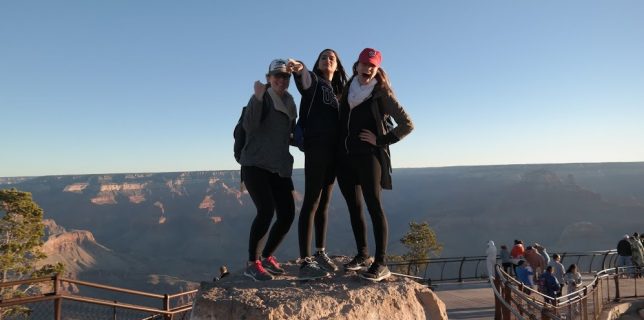A blog post from SOLES Ambassador and Master’s Credential Cohort (MCC) 2-year, Colleen Stevenson
To fulfill my international experience requirement, I chose to go on a road trip with other members of my cohort to the Navajo Nation in New Mexico. Here’s a few ways the experience influenced my perspective of teaching:
- Students need to get outside.
So much of what we discuss in our classes at USD surround the importance of creating culturally relevant lessons and connecting what students are learning to the real world. During our road trip we stopped at various national parks between California and New Mexico. It was amazing to see how the educational practices and theories that I was learning in school began to connect in the real world as we ourselves were learning about new cultures and historical sites. When opportunities to teach beyond the classroom walls arise it should be taken. Not only does it allow for a break outside of the norm, but it shows students that learning can happen anywhere.

- If can’t get out of the classroom, bring the outside to them
Making real world connections is key to student engagement and lesson retention. So when the real world comes into their classroom it’s hard to look away. During our trip we visited the Petrified Forrest National Park in Arizona and while the three of us all teach different subjects we each found a connection from the park to bring into the classroom.
For history, the park’s ancient ruins became a resource for how societies form including hierarchies and social structure. The park’s petroglyphs sparked conversation about language through visuals and in an English classroom could be a text for what communication can look like. And for the elementary or science classroom, students could discuss how the markings stayed on the rocks after all these years.
Be it pictures, mementos, or artifacts students deserve to see the world around them. We need to show students that school is not bound to four walls but bridges the gaps to the world around them.

- Don’t Take a Picture and Read About it Later
Do your research. The more you understand on a topic the more appreciation you will receive. In my placement, I talk to my students about the importance of knowing when a text is written and the background of the author. The more you know, the more you can infer why a text was written, and in turn the larger purpose or message. Without the previous knowledge, the Petrified Forest would seem like a large space of rocks. The layers within the Grand Canyon would seem like neat shading, and the alien themed storefronts in Roswell, New Mexico would seem out of place.
Giving your students the background they need increases their access points to the text or lesson while also expanding their ability to make deeper, stronger, and more meaningful connections. Additionally, asserting the background knowledge of your students’ unique personalities into a lesson is helpful towards increasing classroom engagement.

- Don’t be Afraid to Ask
Be it for directions, background information, or the nearest gas station. Freeways were a new territory, just as many of the skills we teach in the classroom are new territory for our students. When students are afraid to ask questions, they could end up wasting time doing a project incorrectly, only to have needed 2 minutes of clarification to have properly understood the assignment. Same goes for new teachers (maybe even double). Don’t be afraid to ask your colleagues, mentors, or administration for help. Most importantly, don’t be afraid to ask for advice.
Speaking up is a powerful skill, one that our students can even learn from our example. It’s the difference between staying in the dark for fear of looking foolish and turning on a light because being in the dark isn’t helping.
Or in our case, waiting at a rest stop for a tow truck to bring us gas when we only needed to ask the rest stop manager for help.
Head ups: They always have extra gallons to spare.


